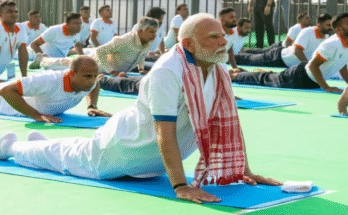
*India Ranks Fifth in Air Quality Index, with 13 of the World’s Most Polluted Cities*
 by Prof. Man Mohan Prakash
by Prof. Man Mohan Prakash
Independent Journalist
India is ranked fifth among 138 countries for air quality, according to the World Air Quality Report 2024 by Swiss technology company IQAir. Shockingly, 13 of the 20 most polluted cities in the world—accounting for 65% of the total—are situated in India. The report highlights that India is home to both the world’s most polluted city, Bernihat, and the most polluted capital, Delhi.
This “achievement” is far from a cause for celebration; it is, in fact, deeply troubling. It comes at a time when the world is watching India, as the nation strives to emerge as a developed, self-reliant global power. Over the past decade, India has made substantial progress in various sectors. The economy has surged, moving up to the fifth-largest globally, with ambitions to reach third place. India has attained self-sufficiency in key areas such as agriculture, food production, IT services, pharmaceuticals, space technology, and partial defense production. The country is also gearing up for self-sufficiency in electronics, semiconductors, solar and green energy, defense, and high-tech military equipment.
In the midst of these impressive advancements, India’s persistent ranking among the most polluted countries is a disheartening and shameful reality. Why does a nation with such scientific prowess, capable of transforming the impossible into reality, struggle to address pollution? India has independently developed nuclear power, mastered cryogenic engines (GSLV Mark-III), created anti-satellite missiles, built indigenous fighter jets (Tejas), nuclear submarines (INS Arihant), aircraft carriers (INS Vikrant), and supercomputers (PARAM series). India has also led digital revolutions with initiatives like UPI and Aadhaar and produced vaccines like Covaxin and Covishield to combat COVID-19.
Given these remarkable achievements, why does pollution—be it air, water, or otherwise—remain such a challenge? The IQAir Report 2024 serves as a wake-up call for all Indian citizens, politicians, industrialists, administrators, and scientists. It’s time to confront some hard-hitting questions:
- Why are the air quality levels in some Indian cities, including the capital, worsening?
- Are the causes of pollution insurmountable?
- Why have Indian scientists and the administration not implemented a permanent solution?
- Should we accept living in polluted environments as a norm?
- Why are Pollution Control Boards at the central and state levels unable to maintain cleaner cities?
- Why are citizens being forced to live in polluted cities?
- Why don’t people take collective responsibility for reducing pollution?
- Are factors such as urbanization, industrialization, population growth, mismanagement of resources, lack of public awareness, and government inaction driving this crisis?
India is seen by the world as an emerging global power, a rapidly growing economy, and a nation striving for self-reliance. Every Indian takes pride in the country’s progress. Yet, air pollution continues to cause widespread harm—leading to severe health conditions such as lung and heart diseases, cancer, and even premature death. Year after year, we discuss pollution, especially during the winter months, but no sustainable solutions emerge. Efforts to curb vehicle emissions, construction dust, and stubble burning remain largely theoretical. The questions remain: Why has real progress been so elusive, and how long can we ignore this issue?
It is time for every citizen, both common and influential, to realize that eliminating pollution is not solely the government’s responsibility. Each individual plays a crucial part. Have we ever paused to consider who is responsible for burning garbage on the streets, setting fire to stubble in the fields, driving polluting vehicles, destroying greenery, or releasing toxic emissions from factories? When will we step up and act like responsible citizens?
Air pollution is a recurring issue, receiving attention through annual reports, news debates, and social media trends, but it often fades into silence shortly after. This cycle is almost laughable—everyone is aware of the problem and the solutions, yet we consistently fail to take meaningful action. It’s time for India to break this cycle and find lasting solutions for a cleaner, healthier future.



